#North Rio Grande Railroad
Text
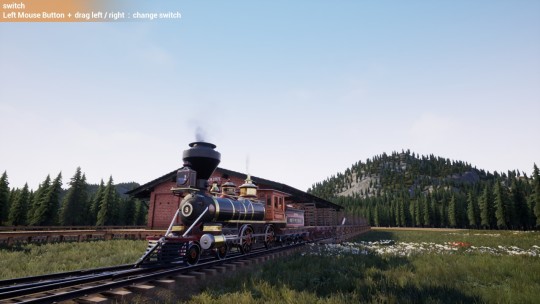
Our Railway's Number 9, and my second engine, Zephyr. When I last drove her she was severly allergic to staying on the rails at speed. Hopefully this latest update fixed that, as she is a lovely engine, and well behaved as long as you watch her speed.
13 notes
·
View notes
Text
GE PowerHaul

After I offered, @valtionrautatiet-official asked me to post some pictures of the locomotive that is nowadays known as the Dr20, used by the private freight operator North Rail in Finland. Here it is in 2012, long before anyone ever even considered sending it to Finland, in Berlin. The reason that it's in Berlin specifically is that it's at Innotrans, the biggest trade fair and exhibition for railroads that exists. At this point it had the paint job of HHPI (Heavy Haul Power International, despite the important sounding name really just one of many European freight rail companies with headquarters in Germany), with their trademark blue and red and their company policy of putting Newton's second law on it. "Project Power" also sounds cool, doesn't it? Well, it turns out they never entered service for HHPI. Way too much history under the cut.
The story behind these eight locomotives is weird and opaque, and there is a lot of stuff we may never know, but on a very fundamental level it seems to be one of the victims of what I call the six-axle diesel curse. This basic of that theory of mine is that it's impossible to sell big, heavy, powerful diesel locomotives, the kind that are so powerful that they need six axles for all the weight from their big engine and diesel tank, in (West) Germany and to a certain extent central and Western Europe, at least nowadays, unless you do it by accident.
The German locomotive industry has wanted to build big six-axle diesel locomotives since the end of steam traction. There was a prototype six-axle version of the V 200, named V 300, in the 1950s, but DB didn't want it (a related but less powerful version was sold to Yugoslavia to haul Tito's private train). For the Americans here, the Krauss-Maffei locomotives of the Southern Pacific and Rio Grande were related to that.
A few years later, in 1962, we get the V 320, a six-axle version of the V 160 locomotive family. The four-axle version was very popular and is still in service, but they only built the prototype of the six-axle version. Interestingly, that one prototype is still around as well, hauling construction trains. Deutsche Bahn was never interested, they preferred the flexibility of having more smaller units. And anyway, they were busy electrifying the busy main lines that would have made the most use of those heavy machines.
In the 1970s Henschel and BBC (the electric equipment one, not the British TV one) built three copies of the DE 2500 both with four and six axles, but those were really more experimental machines.
In the late 1980s and early 1990s, MaK tried to sell their DE 1024, and I actually have a picture of that ne.
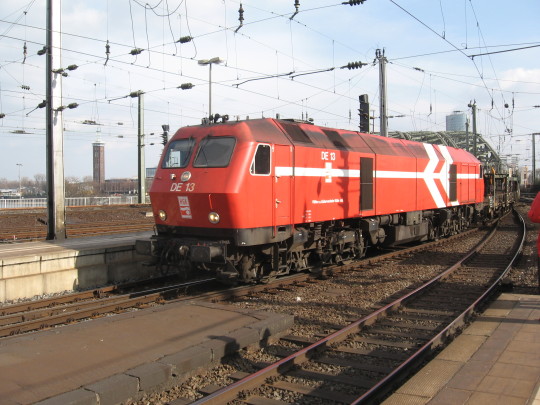
They built three prototypes, and Deutsche Bahn seemed to genuinely toy with the idea… but in the end it was decided to electrify the lines in the (mostly flat) north that hadn't been electrified yet anyway.
And at the same time, the wall fell, and suddenly Germany had access to all the locomotives of the east, now mostly surplus since mostly the industry they served did not survive the transition to western markets. East Germany had bought powerful six-axle diesel locomotives in enormous numbers from the Soviet Union, specifically modern-day Ukraine, and those were available, good enough and already paid for. In particular the class 232 and related, known as "Ludmilla" among rail fans, have proven very useful.
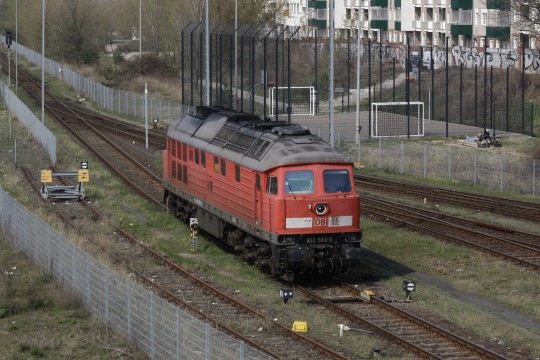
MaK was able to sell an altered version of that locomotive to Norway, but that turned out to be be a huge disaster as they developed a habit of catching on fire. Eventually Siemens (who briefly owned MaK) had to take them back, and since then they've changed hands an astonishing number of times - apparently right now Hector Rail and RDC Autozug have a lot of them. Here's one in Hamburg Altona when it was used on regional trains there.

The three prototypes went to locally owned operator HGK, where two of them also burned down. DB probably dodged a bullet there. Interestingly enough, the only one that didn't burn down was number 13, but that was finally scrapped a few years ago.
In the mid-1990s, ADtranz (later Bombardier) and GE got together to build the Blue Tiger locomotive, a very distinctive-looking and noisy machine. They sold 11 to various private operators in Germany, 30 to Pakistan and 20 to Malaysia. Not terrible, but not a huge success either.
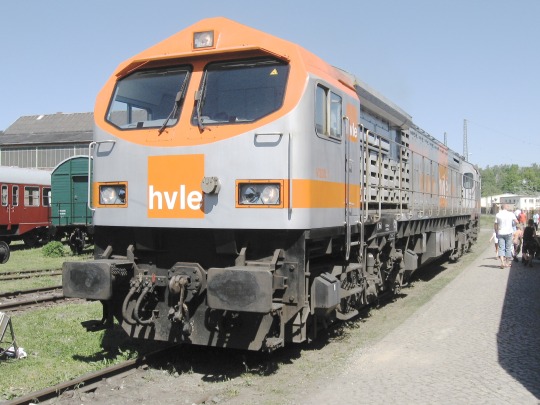
But in the 2000s, things were changing. Liberalisation meant that more and more companies were running services all throughout Europe. The busy main lines were electrified, but many of the border crossings weren't yet, so there was a new need for big six-axle diesel locomotives.
The big beneficiary of this was EMD from North America, who were already supplying such locomotives to Great Britain. The rail companies there needed these machines to replace unreliable British-built power, and to replace environmentally friendly electric locomotives, because most of the British network is not electrified and the few sections that are have way too much traffic on them.
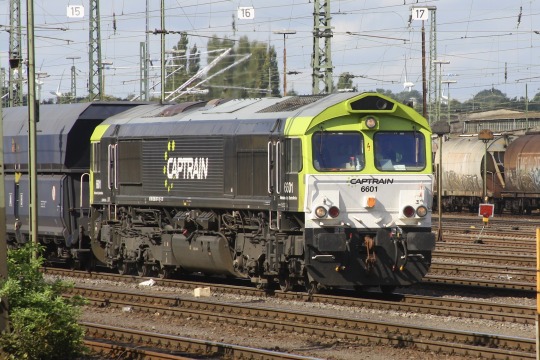
The Class 66 is an ugly mess, designed by figuratively building a metal shed in the inside of a tiny British rail tunnel. It's so noisy that drivers in Norway get hazard pay for being in them. But it works and it was mass produced, and a lot of them made their way to the continent in short order.
Other companies wanted in on that business. Voith decided to enter locomotive building after previously supplying traction equipment. They had high hopes for their Maxima series of locomotives, which they started building in 2008, and they had their own leasing company. They did a lot of marketing and the machine won prestigious design awards.
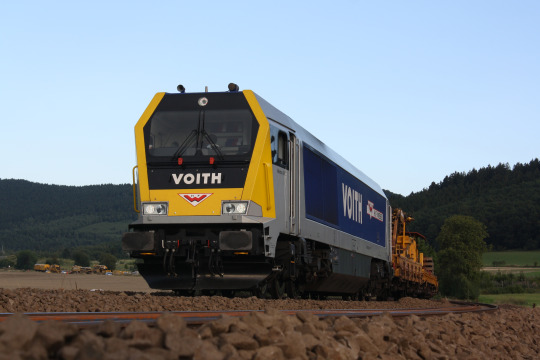
At one point they had a hundred pre-orders. In the end their own leasing company folded, and they only built twenty, which they didn't even manage to sell that quickly. Nowadays they've stopped producing locomotives again.
General Electric, the other North American locomotive company, wanted in on that action as well. Sure, it hadn't worked with the Blue Tiger, but years had passed and things were different now. For their new product, the PowerHaul, they decided to follow what EMD had done. They started with the class 77 for the British market, first shown at Innotrans in 2010.

Then they wanted to work their way out to wider Europe, with a special continental version that was designed with a bigger shell to match the larger tunnels on the continent. That way they weren't quite as cramped. EMD had considered a similar idea, a European-sized class 66, but decided against that.
GE also did not intend to make them themselves. Instead after the initial batch of British 77s, they transferred production to their Turkish partner Tülomsaş, who supplied some more British ones and the ones for central Europe. 29008 is one of them.
In the end all of these plans fell through. A lot of the international border crossings did get electrified much quicker than the diesel sellers had hoped. The one near where I live, the Montzenroute, started electric running in December of 2008, and it was actually the makers of electric locomotives who made bank off of the new international railway world. Here is a Bombardier TRAXX electric locomotive during the first week that freight trains from Germany to Belgium were running with electric power, just a few hundred meters from the border.
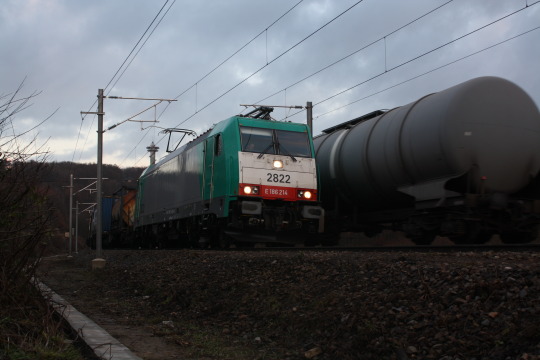
But the business changing is one thing, the story of the PowerHauls seems to be even more complicated. After all, GE did have a launch customer for their PowerHaul, in the form of HHPI. The locomotives were built, painted in HHPI colors, and tested. And then… well, nothing. They never entered service, instead sitting for years in Cottbus, Germany. I have no idea whether they ever got approved for service in Germany. Finnish Wikipedia says "HHPI had no use for them", but that sounds like a euphemism. Clearly HHPI had some use for powerful locomotives, they've recently taken delivery of some Stadler EuroDuals.
The EuroDual and the closely related Euro9000, pictured below, seem to be the solution to the six axle diesel curse though the conceptually simple but technologically difficult trick of simultaneously being a very powerful electric locomotive as well. They have already delivered more of them than Voith Maxima, GE Blue Tiger and GE PowerHaul combined. Sorry for the pictures, they don't park the locomotives well for good photos at Innotrans.
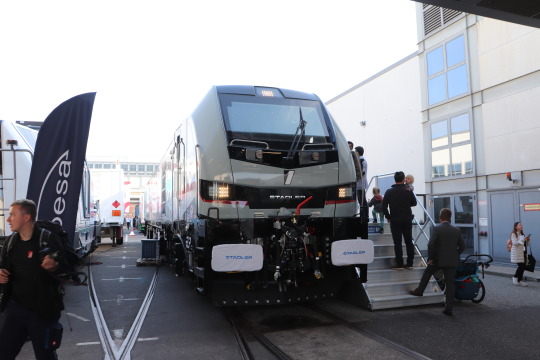
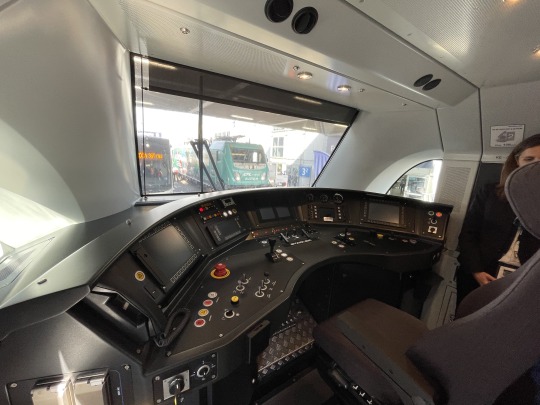
Also, GE was not able to find any customer in Germany, nor in Sweden, where some units of that type were tested at some point. Locomotives of that type were built for Turkey, though, and I haven't heard anything negative about them there. Those were also at Innotrans, in 2014.
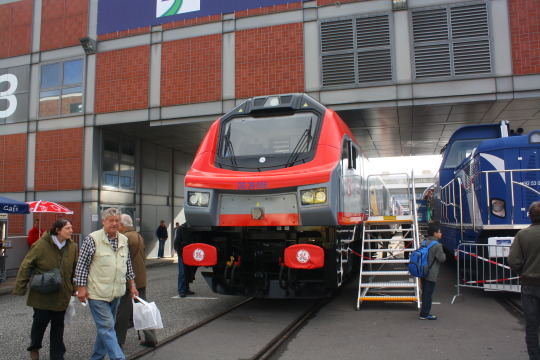
And then, years after everyone had forgotten about these machines, they suddenly turned up in Finland, in the hands of North Rail (formerly Operail), one of the few private companies there. That required at least new couplings, new axles (Finland has a different rail gauge, the measurement of how far the rails are apart), probably adjustments to the breaks, new train control systems and so on.
It's possible that North Rail was thoroughly convinced by the advantages of GE's concept or something, but I think it's far more likely that they just got a really good deal because GE was happy someone took them off their hands.
The reason they're in Finland is almost certainly that Operail needed some cheap machines that weren't doing anything, and these units were just that. But why were they not doing anything? Why were these machines doomed to sit in Cottbus for years, essentially still in new condition, painted for an operator that didn't want them? I'm sure you'll find plenty of theories if you look on online forums, and it's even possible that one of them is the truth, but unless some rail journalist decides to really dig into that, we'll probably never know for certain.
If you allow me to speculate: It certainly doesn't sound like a success story, and there have been all sorts of other stories where trains didn't get approval to run in the country they were ordered for, or had severe technical defects. Ask an Austrian rail fan about the Talent 3, a danish about the IC 4 or a dutch or Belgian about the Fyra to get some really fun rants. I don't know if these locomotives belong in that hall of shame, but it would certainly be an explanation.
My guess is that there won't be any more of these machines ever. GE Transportation doesn't even exist anymore, the whole part of the business got sold to Wabtec a few years ago. But if these machines are doing well in Finland now, good for them! Finally someone found something to do with these weird-looking units.
16 notes
·
View notes
Text
How Helper (Utah) Got Its Name, and Other Stories
Helper, Utah, and environs. (this is on the northern outskirts, and according to some maps, this was part of a hamlet, or maybe just a siding on the Denver and Rio Grande Western Railroad, called Martin at some time in the past. Maybe the locals still call it that.
In October 2022, I took a driving trip that took me to Salt Lake City, Moab, and the North Rim of the Grand Canyon, among other…

View On WordPress
2 notes
·
View notes
Text
Okay RWS/TTTE Tumblr, I have to share possibly the funniest "RWS is a fucking documentary" story ever, as relayed by Youtuber Hyce telling the story while three other guys at the Colorado Railroad Museum try to guess what happened next: (go watch it on YouTube for a good ab workout)
I think the synopsis on this incident being read is here?
This is an absurd week-long saga involving seven different engines getting stuck or derailed, sometimes repeatedly. In a nutshell, behind a keep reading so you can guess along with the video:
To set the stage: The Rio Grande Southern was a crappy podunk railroad in Southwestern Colorado. I'm getting the vibe that this was kind of the real-life equivalent of the Mid Sodor Railway. Relevant locations are Ridgway, the northern terminus, Durango, the southern terminus, Rico, a town kind of in the middle of the line, and Lizard Head Pass, the highest part of the line, which is between Ridgway and Rico. On either end the RGS meets a larger and more competent railroad, the Denver and Rio Grande Western.
Rio Grande Southern #20 gets stuck in the snow while traveling South from the north terminus of its line in Ridgeway. In the middle of the night, in the mountains. It sounds like in a snowstorm.
The next day, two other engines, RGS 22 and RGS 42, come up the mountain from the other direction with a snowplow to free it, along with a little railcar that was just trying to deliver the mail. They set off back towards the south and all of them almost immediately get stuck again.
After three days of the original train, the rescue train, and the railcar all being stuck in the snow, two more rescue trains are sent from either end of the line. On the northern end, the superintendent of the railroad and "every available man" set out with the only engine present, Denver and Rio Grande Western #455, who was leased from the neighboring railroad and probably really wants to go home. On the southern end, D&RGW #458 is "borrowed" to go help, which I think means this engine was not even leased, this is just an engine from a completely different railroad that has to come help because the RGS has gotten basically its entire fleet stuck and the one remaining engine, #41 is small and not very strong.
The superintendent's rescue train also gets stuck, and the borrowed engine's tender derails and rolls over. Neither of them get anywhere near the stuck train. There are now three stuck rescue trains and the original train gets stuck too.
D&RGW #271, who is also not actually part of the railway with the stuck train, comes up with a breakdown crane to put 458's tender back on the rails. This is successful, and 458 continues on towards Rico. 271 apparently decides not to deal with this whole cursed rescue mission, and decides to go home and take the crane with it. On the way home, 271... gets stuck in the snow.
271 gets unstuck by its crew and goes home. 458 meets up with #41, and they take the rotary snowplow up to free the original rescue train, consisting of #20 (which has now been stuck in the snow for SIX DAYS), #22, #42, and the railcar). They FINALLY free the stuck train, and head back towards Rico.
On the way back down, #458 and #41 derail AGAIN.
They finally make it back to Rico... meanwhile the superintendent and #455 are STILL FUCKING STUCK on the other side of the pass.
Poor #458, who is not even supposed to be here and might have some sort of damage from the tender derailment but I'm pretty sure is the biggest and strongest engine here, sets out with the rotary plow again to rescue its sibling, but the damaged tender derails TWO MORE TIMES.
458 gives up and tries to turn back (RWS translation: this poor engine's probably sobbing about wanting to go home by now)... but a couple miles outside of town is blocked by an avalanche!
458's crew (and presumably the rotary plow's) just fucking abandon their engine and walk the rest of the way.
Eventually, some time later RGS #20 and #42 go and free the superintendent. #458 has presumably gone home and refused to set wheel on the RGS ever again.
But the ultimate "RWS is a fucking documentary" moment: 84 years later, the Rio Grande Southern Railroad is a distant memory. The only survivors of this whole clusterfuck are RGS #41, RGS #42, the Railcar... and RGS #20, which has been right there next to the guys telling the story the entire time while they have been absolutely losing it and roasting the fuck out of this railway for the last 20 minutes. Everyone remembers this and starts joking about how they've probably given their steam engine PTSD flashbacks and apologizes to her.
25 notes
·
View notes
Photo

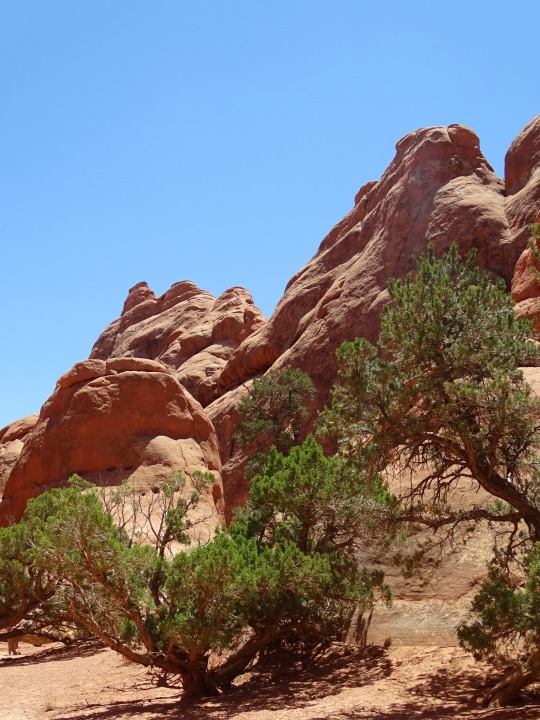

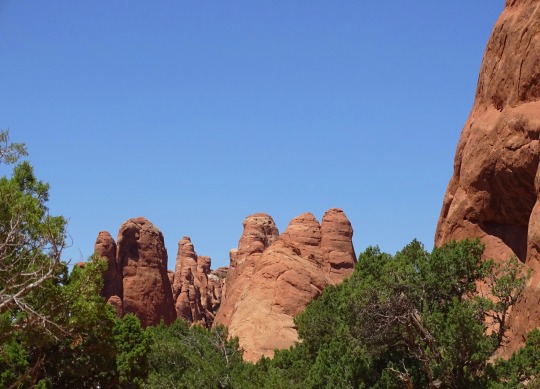


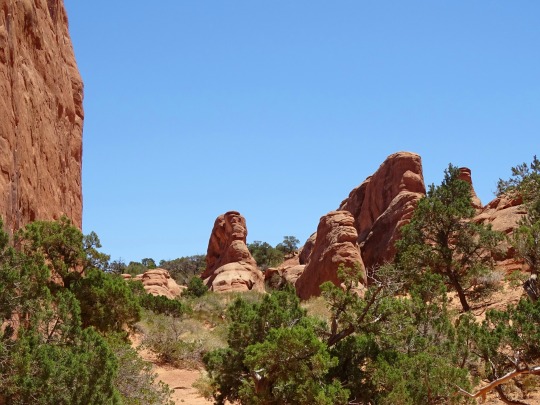

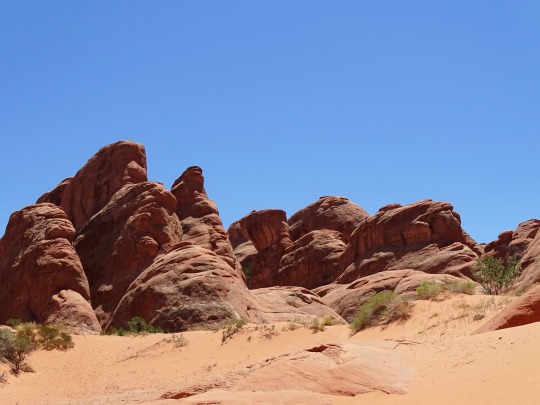

Devils Garden, Arches National Park (No. 2)
In the early 1920s, an immigrant prospector from Hungary named Alexander Ringhoffer came across the Klondike Bluffs, a similar area with fins and arches to the west of Salt Valley, which he named Devil's Garden. Ringhoffer contacted officials at the Denver and Rio Grande Western Railroad to determine whether the land could become a tourist attraction. The railroad company realized the lucrative potential of the area and contacted the National Park Service to consider making it a national monument. President Herbert Hoover signed an executive order on April 12, 1929 that created Arches National Monument. The monument originally consisted of two parts: the Windows and Devils Garden, with the latter name being taken from Ringhoffer's name for the Klondike Bluffs, an area not initially included in the park. Arches remained a national monument until 1971 when Congress passed a bill that re-designated it as a national park.
The Devils Garden trailhead and campground are located 18 mi (29 km) from the park's entrance station at the end of the main park road. The trail through the Devils Garden, including the primitive loop section and spurs, has a total length of 7.2 mi (11.6 km). The primary trail to Landscape Arch is a graded gravel path, while the primitive loop trail, which begins and ends at Landscape Arch, is more challenging with steep, sloping surfaces and close proximity to drop-offs. Landscape Arch, with the longest span of any natural arch in North America, is reached after a 0.8 mi (1.3 km) outbound hike, while Tunnel Arch and Pine Tree Arch can be seen on short spur trails located along the trail to Landscape Arch. Several other arches, including Partition, Navajo, Double O, and Private Arch, as well as the Dark Angel monolith and Fin Canyon, are accessed via the primitive loop trail and its spurs. Wall Arch, before its collapse in 2008, was also located in Devils Garden just north of Landscape Arch.
Source: Wikipedia
#Devils Garden#Arches National Park#flora#red rock#rock formation#cliff#nature#bush#original photography#summer 2022#travel#vacation#USA#Utah#Western USA#geology#desert#landscape#countryside#landmark#tourist attraction#blue skin#trail#hiking#small tree#Grand County#Colorado Plateau
10 notes
·
View notes
Text
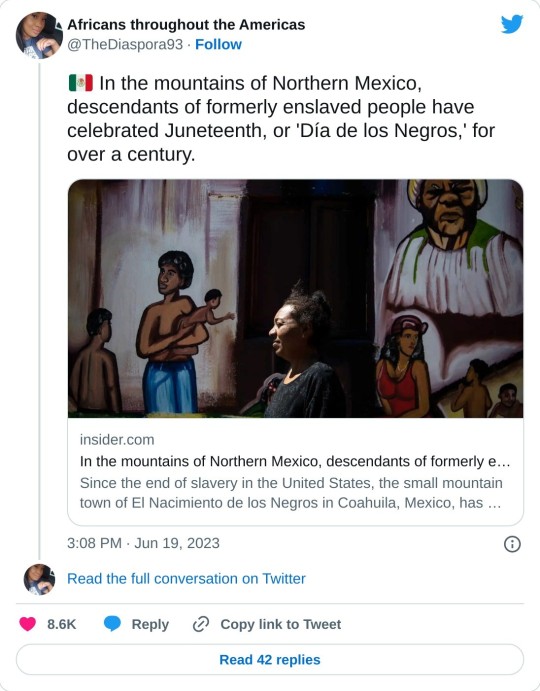

Black Seminole tribal members of El Nacimiento de los Negros have celebrated their version of Juneteenth since the 1870s.
When Mexico outlawed slavery decades before the United States, thousands of Black Texans found a new route to freedom.
Their descendants meet in Coahuila, Mexico, every year for Juneteenth celebrations.
Just over 100 miles from the Texas-Mexico border, a small mountain town in Coahuila, Mexico, is preparing for their annual Juneteenth celebrations.
El Nacimiento de los Negros, translating to "Birth of the Blacks," is home to a community of Afro-Indigenous families that trace their roots back to the United States. Known as "Mascogos," the group are descendants of Black Seminoles who found a home in Mexico after fleeing slavery and the threat of slave catchers in the US.
Black Seminoles were formerly enslaved people who escaped the plantations they worked on and aligned themselves with the Indigenous Seminoles of Florida. The joined forces with the Indigenous tribes to fight the US in the Seminole Wars.
In the 1800s, many Black Seminoles were forced to relocate from places like Georgia and Florida to areas designated Indian Territory in Oklahoma. During that time, Black Seminole chief John Horse, who had both Indigenous and Black ancestry, led a group of people to Mexico, where slavery had already been outlawed. A group settled in El Nacimiento in 1852.

The Southern Underground Railroad
When the General Congress of the United Mexican States completely outlawed slavery in 1837, enslaved people in Texas had a viable route to freedom by going southward. Notably, in the 1936-1938 federal Slave Narrative project, emancipated freeman and San Antonio-born Felix Hayward remarked: "There wasn't no reason to run up north… All we had to do was to walk, but walk south, and we'd be free as soon as we crossed the Rio Grande." By 1849, African Americans began to make the journey into Mexico.
Experts estimate that up to 10,000 people crossed the border to Mexico to secure their freedom and escape slavery, creating what is known as the Southern Underground Railroad.
Contrary to the Union's agreement to return runaway slaves under the Fugitive Slave Act of 1850, Mexican law provided freedom for escaped slaves once they touched Mexican soil. Many of those escaped enslaved people, alongside Indigenous groups of Mexico, helped defend the Northern Mexican border in exchange for acres of land in Coahuila.

Celebrating Juneteenth in Mexico
Juneteenth marks the official end of slavery on June 19th, 1865 when 250,000 Black people in Galveston, Texas were informed of their freedom by executive decree. Historians estimate that as some Black Seminoles traveled back and forth from El Nacimiento to Brackettville, Texas, Juneteenth celebrations spread to Mexico as early as the 1870s.
For more than 100 years, Mascogos in El Nacimiento have celebrated what they call "Dia de los Negros," or "Day of the Blacks," on June 19th. Many Black Seminole descendants still embark on the pilgrimage from parts of Texas to El Nacimiento to celebrate the day. Traditional cuisine includes a sweet potato bread called tetapún and slow-cooked asado pork. The dishes combine Indigenous, Black, and Mexican cultural inspirations.
After generations in northern Mexico, many members of the Black Seminoles in El Nacimiento strictly speak Spanish. However, the hymns passed down from African American descendants are still sung in English on Dia de los Negros, including "Swing Low, Sweet Chariot" and "This Little Light of Mine."
As more Black Seminole descendants are leaving El Nacimiento to find work in Texas or other parts of Mexico, many Mascogos are worried their culture is waning.

To prioritize preservation, members have established the Museo Comunitario Tribu Negros Mascogos for local art, a hotel, a restaurant, and secured federal funding for community gardens. In 2017, the governor of Coahuila declared the Mascogo tribe as Indigenous people of the northern Mexican state.
As Juneteenth was officially recognized as a US federal holiday in 2021, tribal members are planning to promote cultural tourism as a source of support and revitalization for the enduring town, and prevailing traditions, of El Nacimiento de los Negros.
#In the mountains of Northern Mexico#descendants of formerly enslaved people have celebrated Juneteenth#or 'Día de los Negros#' for over a century#mexico#Black People in Mexico#Dia de los Negros#Juneteenth in Mexico
5 notes
·
View notes
Photo

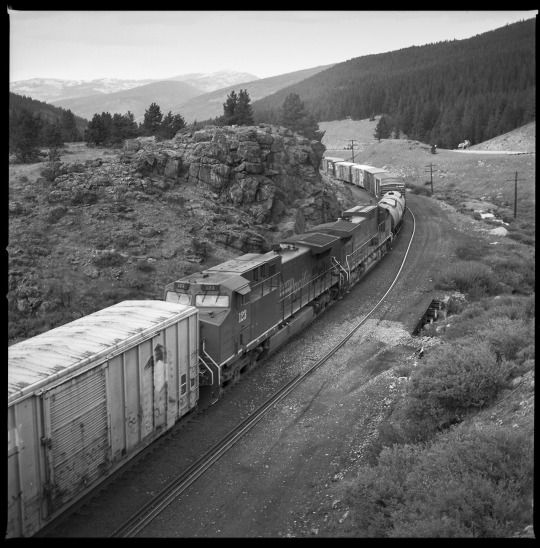
Tennessee Pass
An eastbound train is seen here on the Denver Rio Grande & Western line over Tennessee Pass. This specific locale is just north of Leadville, Colorado, near MP 284—Google Maps has it as Piney Gulch.
A Wisconsin Central EMD SD45 is on the point along with at least one unit from Conrail. This steep grade over the Great Divide demands a lot of horses and so there are two Southern Pacific units working hard at a mid-train position in addition to the six up front. At the time, this was the highest active mainline railroad mountain pass in the United States, but it is currently embargoed, though the tracks are still in place.
I saw a (FB) post of the pass by James Belmont today and so dug around to find these. This was never my turf, and I just happened to be there with my father, medium format camera (filled with Plux-X) in hand. I should say, those eight locomotives were screaming for all they were worth, and the train was moving at about five miles an hour.
Two images by Richard Koenig; taken in the summer of 1996.
#railroadhistory#railwayhistory#tennesseepass#colorado#d&rgw#denver&riograndewestern#southernpacific#conrail#leadville#filmphotography#mediumformat#mediumformatphotography#hasselblad#grainisgood
33 notes
·
View notes
Text
The territorial expansion of the United States in the 19th century significantly altered the map of North America, particularly through the acquisition of lands that include present-day California, Texas, and Arizona from Mexico. This complex process was characterized by diplomatic negotiations, conflicts, and the broader context of Manifest Destiny, a widely held belief in the United States that American settlers were destined to expand across the continent.
### Texas
The annexation of Texas was one of the earliest and most contentious territorial acquisitions. In the early 1820s, Mexico, having just gained independence from Spain, encouraged American settlers to move to its northern province of Texas, offering cheap land in return for the promotion of Mexican culture and law. However, by the 1830s, tensions rose as many American settlers refused to integrate, leading to the Texas Revolution in 1835. In 1836, Texas declared its independence from Mexico, becoming the Republic of Texas. The U.S. officially annexed Texas in 1845, which Mexico viewed as an act of aggression, leading to the outbreak of the Mexican-American War in 1846.
### The Mexican-American War and the Treaty of Guadalupe Hidalgo
The Mexican-American War (1846-1848) was a pivotal event that directly led to the acquisition of the territories that include present-day California, Arizona, and parts of several other states. The war was triggered by the annexation of Texas and disputes over its southern border. The U.S. forces, led by President James K. Polk, who was a strong proponent of Manifest Destiny, quickly overpowered Mexican defenses. The conflict ended with the Treaty of Guadalupe Hidalgo in 1848, which forced Mexico to cede an enormous portion of its territory to the U.S., including the present-day states of California, Nevada, Utah, Arizona, New Mexico, Colorado, Wyoming, and Texas. Mexico relinquished all claims to Texas and recognized the Rio Grande as the southern boundary of the United States.
### The Gadsden Purchase
The territorial ambitions of the United States did not end with the Treaty of Guadalupe Hidalgo. In 1853, the U.S. negotiated the Gadsden Purchase with Mexico, acquiring a further 29,670 square miles of land in what is now southern Arizona and southwestern New Mexico. This acquisition was primarily motivated by the desire to build a southern transcontinental railroad and to resolve ongoing border disputes.
### Impact and Legacy
The way in which the United States acquired California, Texas, and Arizona from Mexico has had a lasting impact on the relationship between the two countries and the development of the American West. The annexation of these territories not only significantly expanded the territorial size of the United States but also introduced a diverse population that included Native Americans, Mexicans, and settlers from various parts of the world. This diversity has contributed to the rich cultural tapestry of the American Southwest.
However, these acquisitions also left a legacy of conflict and displacement. Native American tribes and Mexican residents faced significant challenges in retaining their land, culture, and rights under the new American governance. The history of these territories' acquisition is a reminder of the complex and often contentious paths of national expansion and the importance of understanding and respecting the diverse cultures that contribute to the American identity.

0 notes
Video
youtube
Train Sim World 3 Union Pacific Heritage Livery Collection Showcase
Celebrate the history of US rail with this stunning mix of Fallen Flag schemes, haul freight in colorful style with the UP Heritage Livery Collection for Train Sim World 3, which depicts 6 liveries carried by a fleet of Union Pacific’s SD70ACe locomotives.
-UP SD70Ace diesel locomotive in 6 Fallen Flag railroad liveries:
-UP 1982 Missouri Pacific
-UP 1983 Western Pacific
-UP 1988 Missouri-Kansas-Texas The Katy
-UP 1989 Denver & Rio Grande Western
-UP 1995 Chicago & North Western
-UP 1996 Southern Pacific
-Highly detailed, feature-rich, driving cab
-True-to-life performance and handling
-Includes Training Module on the Training Center
-Includes 6 Scenarios and is operable on the Timetable for Sherman Hill
-Livery Designer, Scenario Planner and Creators Club compatible
Train Sim World® 3: Union Pacific Heritage Livery Collection on Epic Games Store:
https://store.epicgames.com/en-US/p/train-sim-world-3--union-pacific-heritage-livery-collection
Train Sim World® 3: Union Pacific Heritage Livery Collection on Steam:
https://store.steampowered.com/app/1998970/Train_Sim_World_3_Union_Pacific_Heritage_Livery_Collection/
#tsw3 #trainsimworld3 #jimmydali
0 notes
Text
East Mesa, Las Cruces, Nm Actual Estate & Homes For Sale
Blessed by a favorable local weather with 350 sunny days per year, the residents hardly keep at home for a very lengthy time. When the working week ends, the locals normally head to the banks of Rio Grande to have some exciting experience. Hikers just love the Organ Mountains, boasting of breathtaking surroundings at each other step. Then they would probably seize some scrumptious meals to eat and flock to the Zuhl Museum or the Branigan Cultural Center, to tickle their artwork fancy. Numerous festivals and exciting occasions held all 12 months long, just like the Renaissance Arts Fair, Cowboy Days or the Border Book Festival be part of the residents of the city of every age and life-style.
There are 613 lively homes for sale in East Mesa, Las Cruces, NM. Some of the most popular neighborhoods close to East Mesa, Las Cruces, NM are North Hills, West Valley, Valley Creek North, Kohlberg, High Range. The Trails at Metro options fantastically designed open, versatile plans for a wide range of life. Our bright, open-concept homes are surrounded by a variety of amenities that embrace world-class golf, group parks, and provoking views.
Nestled among the serene pecan farmland of the north valley, Rancho del Gallo is a neighborhood of single-family homes on massive ranch-style homesites. Choose from a wide selection of ½-acre homesites and increase your horizons at Rancho del Gallo. In true Las Cruces type, the latest part of Parkhill Estates is heat and friendly, offering a carefree home environment with a captivating neighborhood park. This neighborhood offers easy access to eating places, schools, employment, and a selection of outside recreational opportunities.
Recreation, amenities and a friendly demeanor transfer Las Cruces to the top of the listing for potential home buyers. Find plenty to maintain boredom at bay with the interactive New Mexico Farm and Ranch Heritage Museum. Hike the trails and birdwatch at Mesilla Valley Bosque State Park. The Museum of Nature and Science and the Railroad Museum are two extra fascinating spots.
Both 000 Soledad and 0000 Soledad can be purchased collectively for just under 10 acres total. 2 Slide Outs, Awning, Sleeps eight, Dual A/C Units, Leveling System. This class A Pursuit by Coachmen RV options two large slide outs for added inside house, a set of bunk beds f ... This policy covers how MHVillage, Inc. treats private info that MHVillage collects and receives, together with data associated to your previous use of MHVillage services and products. Personal data is details about you and is specific to you want your name, tackle, email handle, telephone quantity, web site actions, etc, however just isn't otherwise publicly out there. Includes an attractive wooden burning Kiva fire, vaulted ceiling and clerestory windows.
The dealer providing these knowledge believes them to be appropriate, however advises interested events to substantiate them earlier than relying on them in a buy order decision. Copyright © 2023 The Greater El Paso Association of REALTORS®, MLS Inc. The information regarding actual estate for sale on this website is available in part from the Internet Data trade ("IDX") program of the Las Cruces Association of REALTORS®. Real estate listings held by brokerage companies other than , are indicated by detailed information about them such as the name of the itemizing firms.
You can view our full record of home builders in Las Cruces, NM here. Hakes Brothers has been constructing new homes in Las Cruces for over 15 years and has established its status as a premier home builder with local roots. Our team is dedicated to building lovely new homes in sought-after areas, incorporating innovative designs and exceptional options that showcase a real attention to detail. With a concentrate on both craftsmanship and value, our distinctive new homes for sale in Las Cruces, NM, present the amenities of a custom-built home at a fraction of the worth. Live along the sting of the Chihuahuan Desert in the heat metropolis of Las Cruces, New Mexico. This desert oasis provides the perfect backdrop for a model new home.
0 notes
Photo
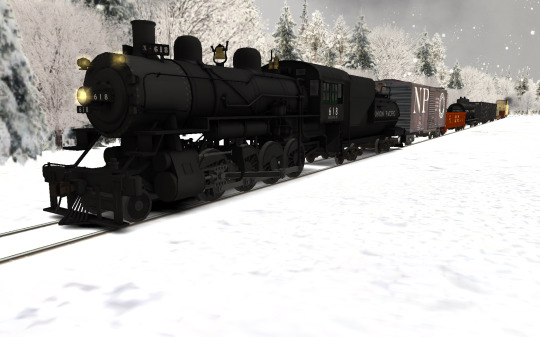
Day 4: Union Pacific 618
Info from Wikipedia:
Union Pacific 618 is a class "C-57" 2-8-0 "Consolidation" type steam locomotive previously owned by the Union Pacific Railroad. The engine is now located in Heber City, Utah and owned by the Heber Valley Railroad. Built in July 1907 by the Baldwin Locomotive Works (BLW) of Eddystone, Pennsylvania, No. 618 is one of 12 surviving C-57 Series locomotives. The locomotive operated in revenue service until 1958. It was then donated to the State of Utah, where it sat on display for many years. In the mid 1960s, a full restoration effort began on the locomotive with the promise of heading up Utah's first tourist railroad in Heber City after the state donated the engine to the National Railway Historical Society. Today, it is one of UP's oldest locomotives and the first steam locomotive to be removed from a Public Park, and put back into operational condition in excursion service. The engine currently is out of service in Heber City, Utah undergoing restoration back to operating condition.
In July 1907, the Oregon Short Line Railroad received #1068. The 2-8-0 locomotive was part of the C-57 Class of locomotives for the OSL, which was a subsidiary of the Union Pacific. The 2-8-0 was part of a three locomotive order from the Oregon Short Line Railroad built that month by Baldwin and numbered 1066-1068.
During World War II, the locomotive pulled trains from the Ogden Yards to the Ogden Army Defense Base. This lasted from 1941-1945 when the Japanese surrendered. Afterward, the engine continued to handle freight in Utah and Idaho. Around 1949-1951, the standard square coal tender was replaced with a Vanderbilt styled tender. The reason why is still unknown. Through the 1950s, the locomotive continued to operate on freight duties until the engine was replaced by diesel locomotives on the Union Pacific. The locomotive's last assignment was to act as a snowplow near the Geneva Steel Mill.
The Union Pacific had decided to donate 618 to the State of Utah with the agreement that the locomotive could not be sold, scrapped, or given to an out of state railroad. In late May of 1958, the locomotive was fired up what some thought was the very last time. She pulled into the Diesel Complex in Salt Lake City. She was then pushed across North Temple Street to the County Fairgrounds and placed on display.
Initially, the locomotive was fairly well received by the public. However, after a while, the locomotive had started to become an eyesore. Many people wanted to get rid of 618, but the stipulations of the Union Pacific giving 618 to the state was that it couldn't be scrapped, sold, or given out of state. This prompted many to speculate what else to do with the locomotive. In the mid 1960s, there was a thought of just burying the engine. According to Stephen Carr, a historian at the Heber Valley Railroad, he stated that, "There was a thought of digging a big hole right next, next to it and tumbling it into the hole. Because nobody knew what else to do with it and nobody was interested in it." In addition, the fairgrounds also were going to be expanded, and the locomotive needed to be moved to allow it. However, members of the National Railway Historical Society decided to step in and in 1969, they convinced the state to donate the engine to the Promontory Chapter of the National Railway Historical Society. After the donation, the group started conversations with the state to use the locomotive in a brand new tourist railroad based out of Heber City, Utah on the Wasatch Railway Museum.
Two years earlier in 1967, the Denver & Rio Grande Western had abandoned the Provo Branch Line that linked Provo to Heber City. The tracks were planned to be ripped up and be turned over as an extension of U.S Route 189. everal locals and businessmen fought to keep the tracks in order to start a potential tourist operation. When the Wasatch Mountain Railway moved their equipment onto the branch, Utah told them to leave. UDOT gave the historical group until April 1, 1972 to move its equipment. The railroad more or less balked at the order and moved #618 to Heber City from Provo on December 7th, 1970.[4] By 1971, the railroad added to their fleet with Pacific Lumber Co. #35 and a 3-Truck Shay #4 from the Yosemite Lumber Company. In January 3, 1971, #618 was fired up and ran the first excursion on the Heber Creeper. In November, the state decided to rescind their eviction and granted the Wasatch Railway Museum a 25 year lease on the former branch. It ran excursion trains from 1971 until 1976 when it was taken out of service. After sitting for ten years, the railroad moved the engine in the shops in 1986 were they began rebuilding the engine. It eventually return to service in 1989 and ran excursions trains until 1990 when it was once again taken out of service and put into storage. In 1992, State of Utah moved all of its railroad equipment for use by the Heber Valley Railroad. For two years, the engine sat on display until 1993 when it went into the shops for an overhaul. The rebuild was completed on May 13, 1995 and it pulled its first train of the 1995 season to Deer Creek Dam and back. In 2007, the locomotive celebration its 100th birthday and was relettered and renumbered as Oregon Short Line No. 1068. Shortly after the event, the locomotive would continue to haul passenger trains for another three years. In June 2010, the locomotive made its last runs before its boiler ticket expired. It haul its last trains during Memorial Day weekends for photo charters and was indefinitely taken out of service and put on static display in front of the railroad dept. n 2014, it was removed from its display track and moved into the shops for restoration back to service, it will be converted to burn oil once finished.
models and route by: Trainz-Forge, Auran, and Download Station
#UP#Union Pacific#Union Pacific Railroad#618#UP 618#Union Pacific 618#Heber Valley Railroad#HVRR#Steam Locomotive#Trains#Trainz SImulator#Christmas#Advent Calendar#Christmas 2022 🎄🎅🎁
1 note
·
View note
Text
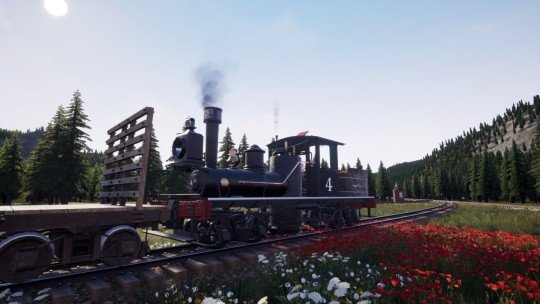
Meet my hyper fixation for the last two weeks, Skrunkly, the number 4 of the North Rio Grande, the Discord's Railroads Online server.
#Railroads Online#Shay Locomotive#North Rio Grande#North Rio Grande No.4#Skrunkly#Smol#Skrunkly my Beloved#Made the other others mad bc I wasn't upgradeing my engine#who needs speed/power when you have a skrunkly#I think our server host was gonna have an anurism when I suggested buying other shay to double head instead of a new loco.
13 notes
·
View notes
Text
Exciting Things To Do In Laredo, Texas
Laredo, Texas, is one of the most popular destinations for tourists from the United States. Laredo, which is the second largest city in Texas, is located about three hours east of San Antonio. Laredo, which became the capitol of Texas oil in the early twentieth century, is famous for its reputation as a railroad town. Many tourists come to Laredo to see the many historic sites and natural wonders around the Laredo area.
Laredo sits on the Rio Grande, which is in fact the largest river in the world. Laredo was originally a trading post for the Spanish-American War, and became a major political and cultural center for the state of Texas. Laredo literally means "riding the river." Today, the area is home to a wide variety of cultural and tourist attractions, including the Historic District, which was designated by President Ulysses S. Grant; Laredo County's first municipal park; and the Laredo Historical Society Museum, which was established in 1923.
The Laredo Renaissance Center is the oldest museum in the state. It offers a glimpse into the history and culture of Laredo and the surrounding areas. In addition to the laredo rafters, the museum has a great range of exhibits that deal with the history of Texas, Mexico, and the United States. The museum also includes a permanent exhibition of the eighteen-century Royal Air Force of Mexico. The exhibit features planes that served during both the American Civil War and the Mexican War.
The second location to consider while traveling through Laredo, Texas is the National Historical Landmark Museum, which is located in Nuevo Laredo. While not in the city proper, this museum is one of the most visited historical landmarks in all of Mexico. Many of the historic homes that line the Nuevo Laredo area were built during the American presidencies of Abraham Lincoln and Ulysses S. Grant.
Nuevo Laredo sits right in the heart of Laredo and the Rio Grande Valley, making it easy to get to any part of the city you are interested in visiting. Just north of downtown Laredo, the Rio Grande Valley Parkway station is one of the best public transportation stations in Texas. Traveling north from Laredo, the metro rail can take you all the way into downtown Mexico. The Rio Grande Valley is home to seven flags of the United States and numerous attractions including the famous zoo hotel.
Just a hop, ski and a jump away from downtown Laredo, you'll find the world renowned Zocalo, which serves dinner and cocktails on its outdoor terrace. Zocalo is one of the most popular dining locations in the city, but it's also the site of one of the seven flags of Mexico. Once again, no matter how far you travel to go to the Zocalo, you will have a great time while enjoying the rich cuisine of this Mexican city. Along with fabulous food, the area offers a wide range of shopping experiences, ranging from luxury boutiques to local shops and everything in between. There's something in Laredo for everyone.
For lodging, there are many hotels in Laredo, ranging from high-class five star resorts to lodges in the comfortable Midwestern style. Laredo is just minutes from Rio Grande, an international destination with everything you would expect from an exotic beach town. Rio Grande boasts a rich history and colourful culture, so it's easy to see why visitors come to Laredo not only for the beaches, but for the nightlife as well. With many staying on the Gulf coast, many hotels are on the waterfront, offering quiet and peaceful accommodations along with convenient access to the beach, restaurants and even bus services that will get you where you need to go.
So, if you're looking for a family vacation or an exciting adventure, consider a trip to Laredo, Mexico, where you can experience the rich history and unique culture found in the United States. You can also enjoy a fun-filled nightlife, great music and exciting sports for all ages, as well as plenty of fun for the entire family. With so much to do in Laredo, Mexico, and in general throughout the United States, no wonder why it has been named one of the top cities in the United States by the United States Department of Tourism. As a result, it is considered to be one of the most popular locations to choose for a family vacation. If you're considering traveling to Laredo, Mexico, contact a travel agent today to schedule your trip.
1 note
·
View note
Video
Through the Narrows by Kevin Madore
Via Flickr:
Propelled by the muscle of two, 94-ton, K-36 Locomotives, the Cumbres & Toltec's Rotary Snow Plow "OY" pushes through the stretch of track known as "The Narrows" about 3 miles north of Chama, NM, en route to Cumbres Pass. To kick off the celebration of the 50th anniversary of the Cumbres & Toltec Scenic Railroad, railroad management elected to rehabilitate and run the line's 1923-vintage rotary snow plow for the first time in 23 years. Unlike previous operations in the late 1900s, the focus of this event was not aimed at opening the line for the tourist season.....the railroad does not begin its regular season until late May. Rather, it was a demonstration, with a target audience of 150 railroad enthusiasts and serious photographers. Participants rode in motor coaches and photographed the rotary outfit from many locations along Highway 17, from Chama all the way to Cumbres Pass, over a period of 2 days. Needless to say, the logistics of conducting this event were daunting and the costs and risks were significant, but the railroad, in cooperation with local businesses as well as state and local government agencies, conducted an event for the ages, delighting virtually everyone who attended. There was enough snow along the entire line to generate a nice snow plume and on the upper reaches of the mountain, there were as many as four feet of snow, giving all attendees a taste of what snow-fighting on the Rio Grande Narrow Gauge looked like back in the day.
2 notes
·
View notes
Photo

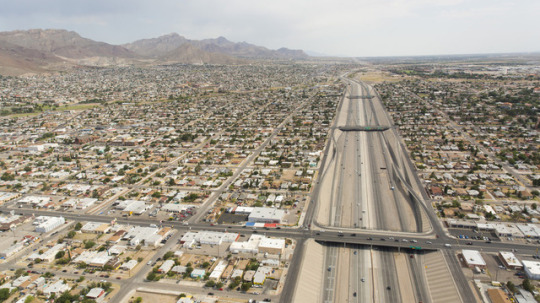
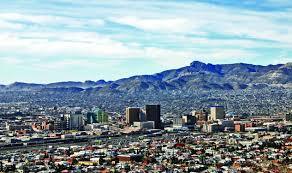
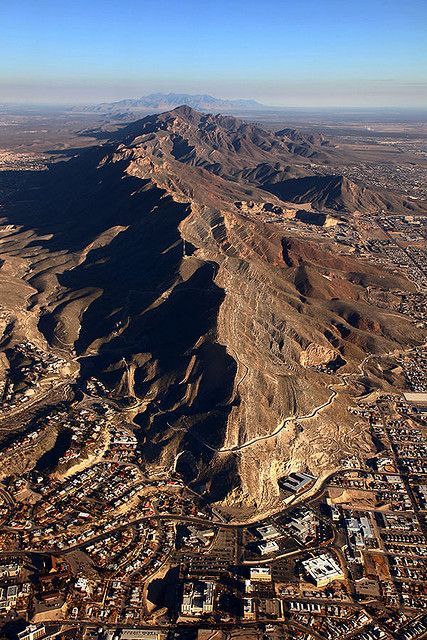
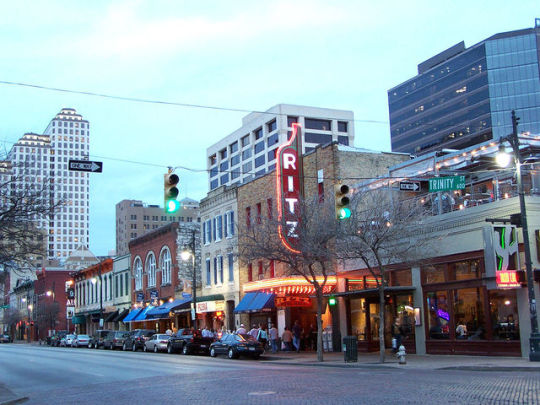
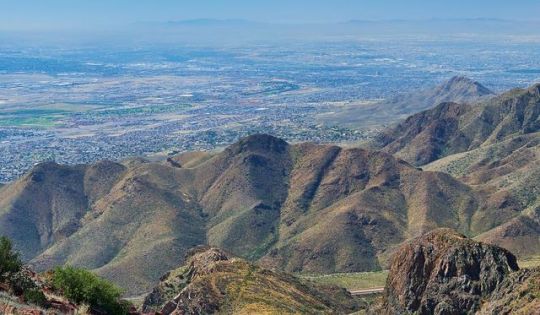
Moving To El Paso, TX
The area's original inhabitants—peaceful hunter-gatherers who roamed throughout the valley and traded their pottery and goods across the desert Southwest—fell victim to disease and warfare brought by the Spanish as well as more hostile Plains Indians from the north.
Spanish explorer Don Juan de Oñate was born in 1550 in Zacatecas, Zacatecas , Mexico and was the first New Spain (Mexico) explorer known to have observed the Rio Grande near El Paso, in 1598, celebrating a Thanksgiving Mass there on April 30, 1598 (decades before the Pilgrims' Thanksgiving).
In 1877 the region had its own civil war, the Salt War of San Elizario , a bloody racial conflict that had little to do with salt, but that set Texan against Mexican, strong man against strong man, faction against faction, and the United States against Mexico.
With the arrival of the Southern Pacific, Texas and Pacific and the Atchison, Topeka and Santa Fe railroads in 1881, the population boomed to 10,000 by the 1890 census, with many Anglo-Americans, recent immigrants, old Hispanic settlers, and recent arrivals from Mexico.
A visit to the Ysleta Mission recalls its stirring beginnings in 1682 and its subsequent importance to the native Tigua people who helped build it. For more modern history, take a walking tour of downtown El Paso , or stop and unwind at Kern Place, an historic neighborhood near UTEP whose bars and entertainment options are a favorite with students.
El Paso is located within the Chihuahuan Desert , the easternmost section of the Basin and Range Region The Franklin Mountains extend into El Paso from the north and nearly divide the city into two sections; the west side forms the beginnings of the Mesilla Valley , and the east side expands into the desert and lower valley.
The Abraham Chavez Theatre, adjacent to the El Paso Convention and Performing Arts Center, welcomes patrons with a three-story-high glass-windowed entry and unique sombrero-shaped architecture, making it a distinct feature on El Paso's southwestern landscape.
According to the Bureau of Economic Analysis ‘s Regional Price Parity survey, which takes into account cost of living metrics including the price of goods and services and housing, El Paso has a regional price parity of 97.4, -11.1% below the average for US metro areas.
Better known as West El Paso or the West Side, the area includes a portion of the Rio Grande floodplain upstream from downtown which is known locally as the Upper Valley and is located on the west side of the Franklin Mountains The Upper Valley is the greenest part of the county due to the Rio Grande The west side is home to some of the most affluent neighborhoods within the city, such as the Coronado Hills and Country Club neighborhoods.
More than 70 Fortune 500 companies have offices in El Paso, including AT&T , ADP , Boeing , Charles Schwab , Delphi , Dish Network , Eureka , Hoover , Raytheon , Prudential Financial , USAA and Verizon Wireless 84 85 Hispanic Business Magazine included 28 El Paso companies in its list of the 500 largest Hispanic owned businesses in the United States.
It is considered a small range (23 miles long, 3 miles (4.8 km) wide) that extends from city north into New Mexico 132 It is home to the highest peak in the county North Franklin Mountain at 7,192 park is open year-round for recreation including hiking, mountain biking, picnicking, scenic driving and views of the city.
Even though it's about 35 minutes outside of the city, most El Pasoans would drive for hours if it meant getting their hands on a chunk of meat from Cattleman's Steakhouse aka The Manliest Steakhouse In America.” Sitting on a 32,000 acre ranch, this place is the definition of cowboy.
New research centers on tap for development in 2017 include the Paso del Norte Research and Business Development Complex, which will house four new research facilities focusing on policy and economic development, economic forecasting, science, and entrepreneur development.
If your considering moving to El Paso Texas be sure to engage with at least 4-5 Discount Moving Companies as prices can rage heavily depending on their routes, time of year and base of operations distance from El Paso.
4 notes
·
View notes
Text
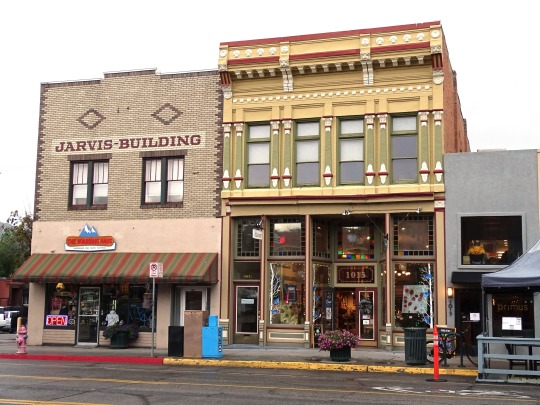
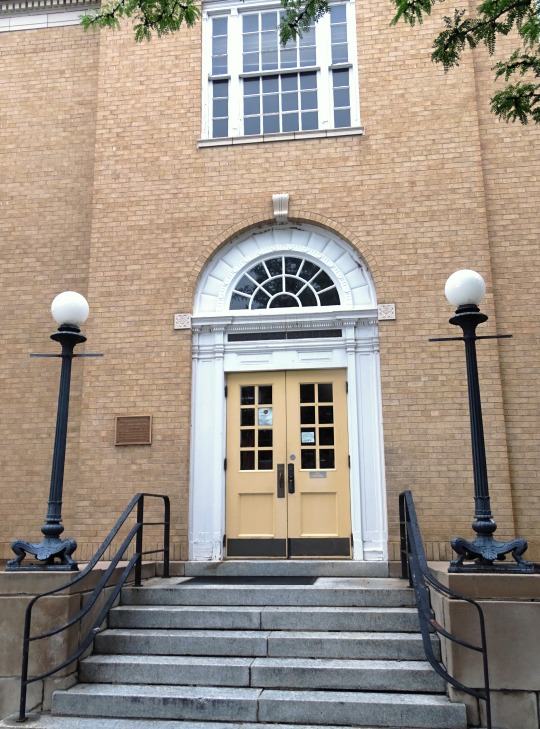

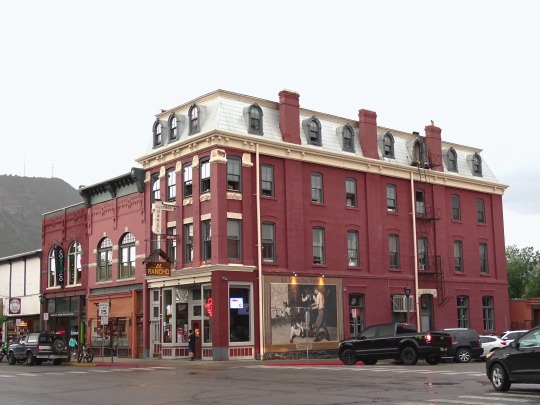
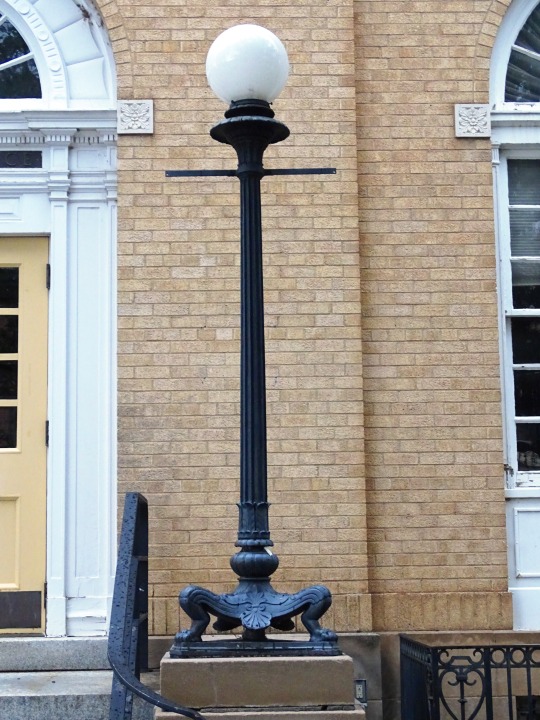
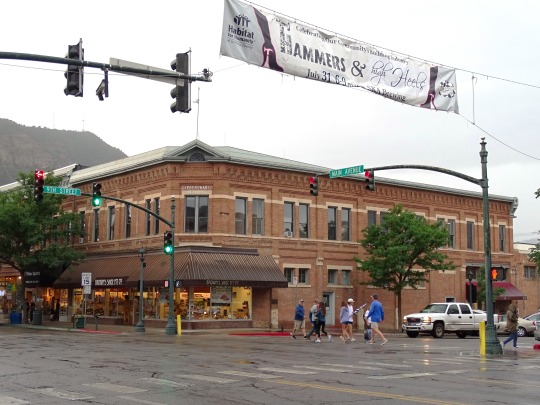
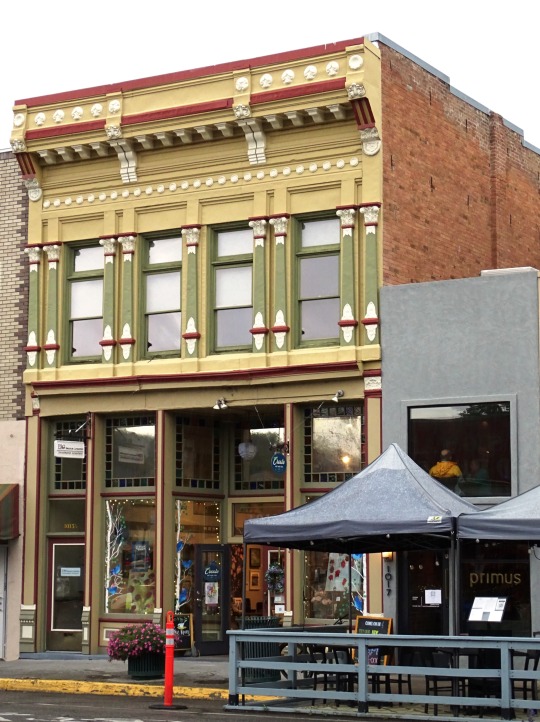



Durango, CO (No. 1)
Durango is a home rule municipality that is the county seat and the most populous municipality of La Plata County, Colorado, United States. The city population was 19,071 at the 2020 United States Census. Durango is the home of Fort Lewis College.
The town was organized from September 1880 to April 1881 by the Denver and Rio Grande Railroad (D&RG, later known as the Denver and Rio Grande Western railroad) as part of their efforts to reach Silverton, Colorado, and service the San Juan mining district, the goal of their "San Juan Extension" built from Alamosa Colorado. The D&RG chose a site in the Animas Valley close to the Animas River near what's now the Downtown Durango Historic Business District for its railroad facilities following a brief and most likely perfunctory negotiation with the other establishment in the area known as Animas City, two miles to the north. The city was named by ex-Colorado Governor Alexander C. Hunt, a friend of D&RG President William Jackson Palmer, after Durango, Mexico, based on his favorable impression of that city resulting from a scouting trip undertaken on behalf of Palmer.
Palmer among other D&RG associates such as William Bell started a subsidiary company known as the Durango Trust to sell land and plan a Main Street, 2nd, and 3rd Avenue, and so on to organize the town, taking inspiration from how Palmer founded the city of Colorado Springs. Sales from the Durango Trust skyrocketed by the completion of the D&RG's Silverton Branch, and by 1885, Durango’s business district had seven hotels and restaurants, eleven saloons, dancehalls and stores, two bakeries and blacksmith shops, and a variety of other businesses, also boosting the town of Silverton’s population to 2,000 at the time.
Source: Wikipedia
#La Plata County#Durango#USA#travel#original photography#vacation#tourist attraction#landmark#cityscape#architecture#summer 2022#Colorado#Mountain West Region#street scene#exterior#Main Avenue Historic District
1 note
·
View note
